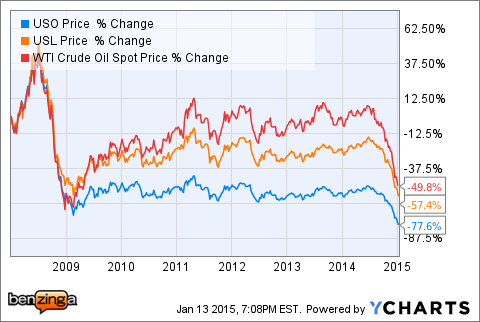One of the hottest topics of debate among investors over the past six months has been when/if to invest in crashing crude oil.
By far, the most popular oil ETF is the United States Oil Fund, LP USO 4.49%, which has nearly 16.5 million average daily trading volume. But should investors be dumping USO and buying the United States 12 Month Oil Fund, LP USL 3.56% instead?
Unfortunately, the unsatisfying answer to that question is “it depends.”
How Oil ETFs Work
Many oil ETFs invest in oil futures contracts. An oil futures contract is a commitment to buy a given amount of crude oil at a given price on a particular date in the future.
Since the purpose of oil ETFs is only to serve as an investment vehicle to track the price of oil, the creators of the fund have no interest in stockpiling actual oil. Therefore, oil ETFs such as USO periodically “roll over” their futures contracts by selling the contracts that are approaching expiration and buying contracts that expire farther into the future.
The Contango Problem
While this process of continually rolling over futures contracts may seem like a great way to track the price of crude oil, there’s a practical problem with the method: contango. The rollover method would work perfectly if oil funds could sell their expiring contracts for the exact same price that they pay for the futures contracts they buy each month.
However, in reality, it’s often true that oil futures contracts get more expensive the farther their expiration date is in the future. That means that every time the oil ETFs roll over their contracts, they lose the difference in value between the contracts they sell and the contracts they buy.
That’s why funds like USO, which invests only in WTI light, sweet crude oil futures contracts, don’t directly track the performance of the WTI crude oil spot price.

Fighting Contango
The creators of USL came up with one way to minimize the contango problem. While USO rolls over its entire oil futures portfolio on a month-to-month basis (by selling the current month’s expiring contracts and investing entirely in the upcoming month’s contracts), USL spreads out its futures contract investment equally over 12 months.
In other words, USL only rolls over 1/12 of its contracts every month by selling the current month’s expiring contracts and investing in contracts 12 months into the future.
This strategy serves to mitigate some of the losses due to contango because only a fraction of the contracts are being rolled over each month and the fund’s investments are diversified over a wider timeframe.

Backwardation
Choosing the best oil ETF is not as simple as finding the one that minimizes contango. Oil futures prices farther into the future are often lower than the prices of contracts that are nearing expiration. In such a scenario, ETFs like USO (that perform monthly rollovers) are selling more expensive current-month contracts, and buying cheaper forward-month contracts.
This scenario is known as “backwardation,” and it is the opposite of contango.
While contango destroys value for oil ETF investors, backwardation creates it. And all the advantages that USL has over USO when it comes to times of contango can become disadvantages during times of backwardation.

Declaring a “winner” between USO and USL is slightly more complicated than simply identifying whether the oil futures market is in a state of contango or backwardation.
The steepness of the futures curve also comes into play. In fact, Seeking Alpha has a breakdown of which fund is the better investment in no less than 12 different scenarios involving the appearance of the oil futures yield curve.
Rules Of Thumb
On its website, Hedgewise details an optimal strategy for switching among different ETFs based on the shape of the oil futures yield curve.
However, for investors that want to keep things simple and don’t have the time and/or the will to analyze the slope of the futures yield curve on a daily basis, stick to this general rule of thumb: In times of contango, USL is likely the better choice, and in times of backwardation, USO is probably the way to go.
For investors who would prefer to pick one of the two and move on with their lives, USL has fractionally outperformed USO in every single year since its inception in late-2007.
Due to the effects of contango, both funds have…
Read the rest of this article (and all my other articles) for free on Benzinga by clicking here
Want to learn more about the stock market? Or maybe you just want to be able to look sophisticated in front of your coworkers when they ask you what you are reading on your Kindle, and you’d prefer to tell them “Oh, I’m just reading a book about stock market analysis,” rather than the usual “Oh, I’m just looking at pics of my ex-girlfriend on Facebook.” For these reasons and more, check out my book, Beating Wall Street with Common Sense. I don’t have a degree in finance; I have a degree in neuroscience. You don’t have to predict what stocks will do if you can predict what traders will do and be one step ahead of them. I made a 400% return in the stock market over five years using only basic principles of psychology and common sense. Beating Wall Street with Common Sense is now available on Amazon, and tradingcommonsense.com is always available on your local internet!

